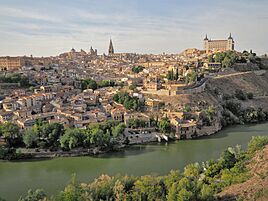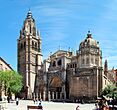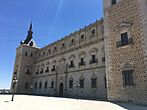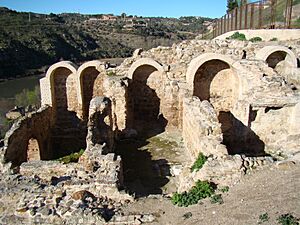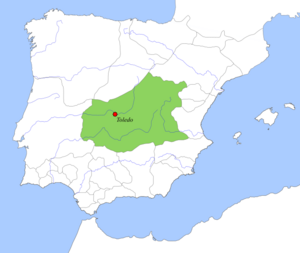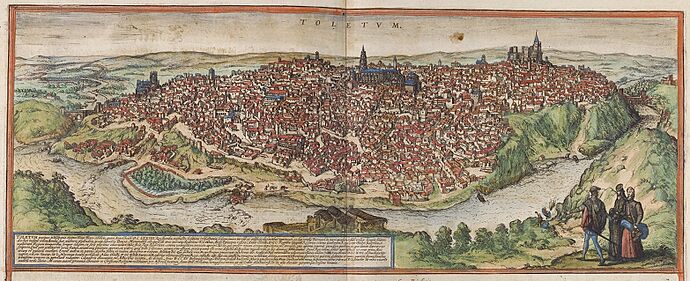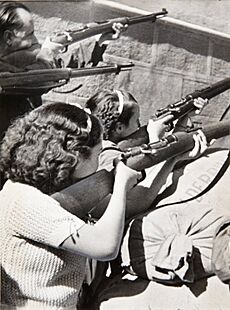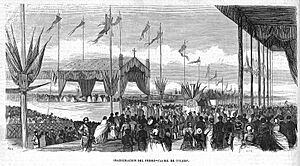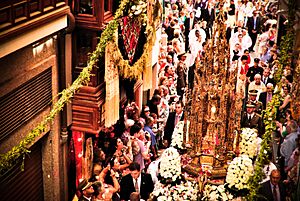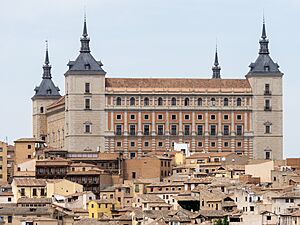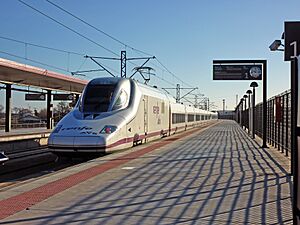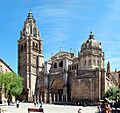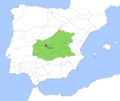Toledo, Spain facts for kids
Quick facts for kids
Toledo
|
|||||||||||||||||
|---|---|---|---|---|---|---|---|---|---|---|---|---|---|---|---|---|---|
|
|||||||||||||||||
| Nickname(s):
La ciudad imperial (The Imperial City) and Ciudad de las Tres Culturas (City of the Three Cultures)
|
|||||||||||||||||
| Country | Spain | ||||||||||||||||
| Autonomous Community | Castilla–La Mancha | ||||||||||||||||
| Province | Toledo | ||||||||||||||||
| Settled | Pre-Roman | ||||||||||||||||
| Area | |||||||||||||||||
| • Land | 232.1 km2 (89.6 sq mi) | ||||||||||||||||
| Elevation | 529 m (1,736 ft) | ||||||||||||||||
| Population | |||||||||||||||||
| • Total | 85,085 | ||||||||||||||||
| • Density | 359.58/km2 (931.3/sq mi) | ||||||||||||||||
| Postcodes |
45001–45009
|
||||||||||||||||
| Area code(s) | +34 925 | ||||||||||||||||
|
|||||||||||||||||
Toledo is a historic city and municipality in Spain. It is the capital of the province of Toledo and the main city of the Castilla–La Mancha region.
Toledo is located in the middle of Spain, on the right (north) bank of the Tagus River. The river bends around the city, making it naturally protected. It is often called the "City of the Three Cultures." This is because Christians, Muslims, and Jews lived there together for many centuries. They all left their mark on the city's culture and buildings.
From 542 to 725 CE, Toledo was the capital of the Visigothic kingdom. Important church meetings called the Councils of Toledo were held here. The city has a beautiful Gothic Cathedral and has been a powerful religious center for a long time. Toledo is also famous for making bladed weapons, especially swords, which are popular souvenirs today. In 1986, UNESCO declared Toledo a World Heritage Site because of its rich history and many old buildings.
As of 2015, about 83,226 people lived in Toledo. The city covers an area of about 232.1 square kilometers (90 square miles).
Contents
City Symbols
Coat of Arms
The city of Toledo received its official coat of arms in the 16th century. This special symbol was based on the coat of arms of the King of Spain. This showed the city's close connection to the Spanish monarchy.
Toledo's Long History
Ancient Times: Romans and Visigoths
The Roman historian Livy described Toledo (then called Toletum) as a "small city, but fortified by location." Around 193 BCE, a Roman general named Marcus Fulvius Nobilior fought a battle near the city. He defeated local Celtic tribes.
Toletum became part of the Roman Empire. It was first a city that paid taxes and later gained more Roman rights. During this time, the Romans built a large circus, city walls, public baths, and a water system. The Roman circus could hold up to 15,000 people. Games were held there until the 4th and 5th centuries, showing the city was still active.
Toledo became more important in later Roman times. Large houses were built inside the city walls. In 546 CE, the Visigoth rulers made Toledo the capital of their kingdom. Throughout the 7th century, many church councils were held in Toledo. These meetings tried to settle religious disagreements. They also created laws against Jewish people. By the end of the 7th century, the bishop of Toledo was the most important bishop in Spain. The city also became a key symbol for the kings.
In 711 or 712 CE, Tariq bin Ziyad captured Toledo for the Umayyad Caliphate. This was part of the Islamic conquest of the Iberian Peninsula.
The Middle Ages: Muslim Rule and Christian Reconquest
After the Muslim conquest, Toledo was known as Ṭulayṭulah. Most of the new settlers were Berbers. The city remained an important center for learning and religion.
Toledo often rebelled against the rulers in Cordoba between 761 and 857. In 852, a major revolt broke out. Toledo even formed an alliance with King Ordoño I of Asturias. However, Cordoba regained control of Toledo in 873 after a long siege.
In the early 11th century, Toledo became the center of its own independent kingdom, called the Taifa of Toledo. About 28,000 people lived in Toledo at this time, including about 4,000 Jewish people. The Christian community, called Mozarabs, had their own bishop.
On May 25, 1085, King Alfonso VI of León took Toledo. After the Christian conquest, many different groups lived in Toledo: Mozarabs, Muslims, Jews, and new Christians from northern Spain. Each group had its own laws at first.
Toledo continued to be a major cultural center. The Toledo School of Translators was set up. Here, Muslim and Jewish scholars translated books from Arabic and Hebrew into Castilian. Then, Castilian scholars translated them into Latin. This helped spread ancient knowledge across Christian Europe.
Modern Era: Royal Court Moves and New Challenges
In the late 15th and early 16th centuries, Jewish people in Toledo wrote about their long history in the city.
After a major revolt was put down, King Charles V often lived in Toledo. He made the city his home at least 15 times from 1525 onwards. The city's population grew a lot during this time. However, in 1561, King Philip II moved the royal court to Madrid. This caused Toledo to slowly decline.
The archbishops of Toledo remained very powerful in Spain's politics and religion. They owned a lot of land.
In the 16th century, many Moriscos (Muslims who had converted to Christianity) from Granada were sent to Toledo. This created challenges and changed the social mix of the city.
Toledo was famous for making silk in the early modern period. This industry was at its best in the 16th century but slowly disappeared by the 1800s.
The Peninsular War in the 19th century badly affected the city. Toledo slowly changed from a city of convents to a city with more government offices.
In 1858, a railway line connected Toledo to the rest of Spain. This helped tourism grow and led to more hotels and restaurants. By the early 1900s, Toledo had about 23,000 people.
During the Spanish Civil War in 1936, the Alcázar fortress in Toledo became famous. A group of rebels held out against forces loyal to the Republic for two months. This event became a strong symbol for the side that won the war.
In 1940, Heinrich Himmler, a high-ranking Nazi official, visited the ruins of the Alcázar.
By 1950, Toledo's population was around 40,243. New neighborhoods were built in the second half of the 20th century.
In the 1980s, Toledo became the capital of the Castilla–La Mancha region. It now hosts the regional parliament and government.
Today, Toledo is still a popular tourist spot. People from all over the world visit its historic places. These include the Toledo Cathedral, the Alcázar, and many old synagogues and mosques. These buildings show its diverse cultural past. Toledo also hosts many cultural events, like the Holy Week processions and the Corpus Christi festival. These events celebrate the region's religious and cultural traditions.
Climate
Toledo has a typical dry climate. Winters are cool, and summers are hot and dry. It does not rain much, mostly in autumn and spring. The hottest temperature ever recorded in Toledo was 44.2°C (111.6°F) on August 13, 2021. The coldest was -13.4°C (8°F) on January 12, 2021.
| Month | Jan | Feb | Mar | Apr | May | Jun | Jul | Aug | Sep | Oct | Nov | Dec | Year |
|---|---|---|---|---|---|---|---|---|---|---|---|---|---|
| Record high °C (°F) | 22.0 (71.6) |
23.8 (74.8) |
29.0 (84.2) |
34.5 (94.1) |
37.7 (99.9) |
42.0 (107.6) |
42.9 (109.2) |
44.2 (111.6) |
41.3 (106.3) |
34.1 (93.4) |
25.6 (78.1) |
22.2 (72.0) |
44.2 (111.6) |
| Mean daily maximum °C (°F) | 11.9 (53.4) |
14.3 (57.7) |
18.1 (64.6) |
20.5 (68.9) |
25.2 (77.4) |
31.1 (88.0) |
35.1 (95.2) |
34.5 (94.1) |
29.1 (84.4) |
22.6 (72.7) |
15.8 (60.4) |
12.0 (53.6) |
22.5 (72.5) |
| Daily mean °C (°F) | 6.8 (44.2) |
8.4 (47.1) |
11.7 (53.1) |
14.1 (57.4) |
18.4 (65.1) |
23.7 (74.7) |
27.2 (81.0) |
26.8 (80.2) |
22.1 (71.8) |
16.6 (61.9) |
10.7 (51.3) |
7.3 (45.1) |
16.2 (61.1) |
| Mean daily minimum °C (°F) | 1.7 (35.1) |
2.6 (36.7) |
5.2 (41.4) |
7.7 (45.9) |
11.6 (52.9) |
16.3 (61.3) |
19.3 (66.7) |
19.1 (66.4) |
15.0 (59.0) |
10.5 (50.9) |
5.5 (41.9) |
2.5 (36.5) |
9.8 (49.6) |
| Record low °C (°F) | −13.4 (7.9) |
−9.0 (15.8) |
−5.8 (21.6) |
−2.6 (27.3) |
−0.3 (31.5) |
4.3 (39.7) |
10.0 (50.0) |
10.0 (50.0) |
5.4 (41.7) |
0.0 (32.0) |
−5.6 (21.9) |
−8.0 (17.6) |
−13.4 (7.9) |
| Average precipitation mm (inches) | 25.3 (1.00) |
24.6 (0.97) |
33.0 (1.30) |
39.5 (1.56) |
38.9 (1.53) |
18.7 (0.74) |
5.7 (0.22) |
8.6 (0.34) |
20.7 (0.81) |
48.7 (1.92) |
37.7 (1.48) |
35.9 (1.41) |
337.3 (13.28) |
| Source: Agencia Estatal de Meteorología (AEMET OpenData) | |||||||||||||
| Month | Jan | Feb | Mar | Apr | May | Jun | Jul | Aug | Sep | Oct | Nov | Dec | Year |
|---|---|---|---|---|---|---|---|---|---|---|---|---|---|
| Record high °C (°F) | 22.0 (71.6) |
23.8 (74.8) |
29.0 (84.2) |
34.5 (94.1) |
37.7 (99.9) |
42.0 (107.6) |
42.9 (109.2) |
44.2 (111.6) |
41.3 (106.3) |
34.1 (93.4) |
25.6 (78.1) |
22.2 (72.0) |
44.2 (111.6) |
| Mean daily maximum °C (°F) | 11.5 (52.7) |
14.0 (57.2) |
18.1 (64.6) |
19.9 (67.8) |
24.2 (75.6) |
30.5 (86.9) |
34.6 (94.3) |
34.0 (93.2) |
29.0 (84.2) |
22.1 (71.8) |
15.6 (60.1) |
11.6 (52.9) |
22.1 (71.8) |
| Daily mean °C (°F) | 6.4 (43.5) |
8.3 (46.9) |
11.6 (52.9) |
13.5 (56.3) |
17.6 (63.7) |
23.2 (73.8) |
26.8 (80.2) |
26.3 (79.3) |
22.0 (71.6) |
16.1 (61.0) |
10.5 (50.9) |
7.1 (44.8) |
15.8 (60.4) |
| Mean daily minimum °C (°F) | 1.3 (34.3) |
2.6 (36.7) |
5.0 (41.0) |
7.2 (45.0) |
11.0 (51.8) |
15.9 (60.6) |
18.9 (66.0) |
18.6 (65.5) |
14.9 (58.8) |
10.2 (50.4) |
5.3 (41.5) |
2.5 (36.5) |
9.5 (49.0) |
| Record low °C (°F) | −13.4 (7.9) |
−9.0 (15.8) |
−5.8 (21.6) |
−2.6 (27.3) |
−0.3 (31.5) |
4.3 (39.7) |
10.0 (50.0) |
10.0 (50.0) |
5.4 (41.7) |
0.0 (32.0) |
−5.6 (21.9) |
−8.0 (17.6) |
−13.4 (7.9) |
| Average precipitation mm (inches) | 26.0 (1.02) |
25.0 (0.98) |
23.0 (0.91) |
39.0 (1.54) |
44.0 (1.73) |
24.0 (0.94) |
7.0 (0.28) |
9.0 (0.35) |
18.0 (0.71) |
48.0 (1.89) |
39.0 (1.54) |
41.0 (1.61) |
342.0 (13.46) |
| Average precipitation days (≥ 1.0 mm) | 4.9 | 4.7 | 3.9 | 6.4 | 6.4 | 2.9 | 1.0 | 1.5 | 2.9 | 6.8 | 5.9 | 6.3 | 53.6 |
| Average snowy days | 0.6 | 0.5 | 0.3 | 0 | 0 | 0 | 0 | 0 | 0 | 0 | 0.1 | 0.2 | 1.7 |
| Average relative humidity (%) | 76.0 | 69.0 | 59.0 | 58.0 | 54.0 | 45.0 | 39.0 | 41.0 | 51.0 | 66.0 | 74.0 | 79.0 | 59.0 |
| Mean monthly sunshine hours | 151 | 172 | 228 | 249 | 286 | 337 | 382 | 351 | 260 | 210 | 157 | 126 | 2,922 |
| Source: Agencia Estatal de Meteorología | |||||||||||||
Economy and Industry
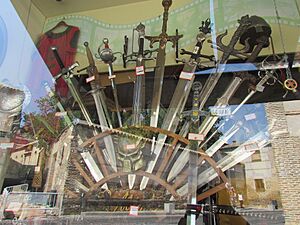
Toledo has a long history of metal-working. It is famous for making swords and knives. The city also produced razor blades, medical tools, and electrical items. Other important industries included soap, toothpaste, flour, glass, and ceramics.
Toledo Steel and Swords
The city of Toledo has been making swords and working with steel since about 500 BCE. The Romans noticed Toledo's swords when Hannibal used them in the Punic Wars. Soon, Roman soldiers used Toledo's weapons often.
Toledo steel was known for its very high quality. Between the 15th and 17th centuries, Toledo's sword-making was very successful. Toledo steel was considered the best in Europe. Individual craftsmen made swords and daggers, and a guild (a group of skilled workers) made sure they were high quality.
In the late 17th century, sword production started to slow down. To help, King Charles III created the Royal Arms Factory in 1761. This factory brought all the city's sword-makers together. It grew so much that it became like a small city within Toledo.
In the 20th century, the factory mainly made swords for military officers. After the factory closed in the 1980s, its building became part of the Technological University of Castilla–La Mancha. Today, many shops in Toledo sell all kinds of swords, from historical ones to those seen in movies. They also sell medieval armor.
Jobs in Toledo
Most people in Toledo work in the services sector (like tourism, shops, and offices). About 86.5% of jobs are in services. Construction makes up 6.6% of jobs, industry 5.4%, and agriculture 1.5%.
Culture and Heritage
The old city of Toledo sits on a mountaintop. It has amazing views and is surrounded by the Tagus River on three sides. It is home to many historical sites. These include the Alcázar fortress, the Cathedral, and the Zocodover, a central market.
From the 4th to the 16th centuries, about thirty church meetings were held in Toledo. These meetings discussed religious ideas and made important church laws. The Treasure of Guarrazar, a collection of beautiful Visigothic art, was found near Toledo in 1858.
Toledo had large communities of Muslims and Jews for many centuries. However, they were later forced to leave Spain in 1492 (Jews) and 1502 (Muslims). Today, you can still see their religious buildings. These include the Synagogue of Santa María la Blanca, the Synagogue of El Tránsito, and the Mosque of Cristo de la Luz. Many Jewish families around the world still have the last name Toledano, showing their connection to the city.
In the 13th century, Toledo was a major cultural hub. King Alfonso X, known as "the Wise," loved learning. The Toledo School of Translators helped bring a lot of knowledge to Europe. They translated important academic and philosophical books from Arabic into Latin. The Palacio de Galiana, a beautiful palace, is from this time.
The Cathedral of Toledo was built between 1226 and 1493. It is a stunning example of Gothic architecture. Inside, you can see the amazing El Transparente altar. This Baroque altar is several stories high and features stucco figures, paintings, and bronze. For a few minutes each day, sunlight shines through it, giving it its name. The Mozarabic Chapel in the Cathedral still uses a special ancient Christian service called the Mozarabic Rite.
Two famous bridges cross the Tagus River into Toledo: the Alcántara bridge and the San Martín bridge.
The Monasterio de San Juan de los Reyes is a Franciscan monastery. It was built between 1477 and 1504. It mixes Gothic, Spanish, and Flemish styles with beautiful Mudéjar decorations.
Toledo was home to the famous painter El Greco for much of his life. He painted some of his most well-known works about the city. These include The Burial of the Count of Orgaz, which you can see in the Church of Santo Tomé.
When King Philip II moved the royal court to Madrid in 1561, Toledo slowly lost its importance.
Toledo's Food
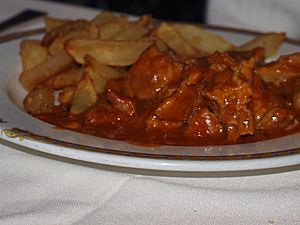
Toledo has many delicious local foods. Some popular dishes include lamb roast or stew, cochifrito, and perdiz estofoda (partridge stew). Carcamusa is a local favorite made with pork and vegetables. Other dishes are migas, gachas manchegas, and tortilla a la magra. Toledo also has its own version of cocido, a Spanish stew. Two very famous food products from Toledo are Manchego cheese and marzipan. Toledo's marzipan even has a special protected status.
Holidays and Festivals
- Virgen del Valle pilgrimage: This is celebrated on May 1 at the Ermita de la Virgen del Valle. It's a popular spot for visitors.
- Holy Week: This spring festival is very important. It includes many processions and religious events.
- Corpus Christi: This is a very famous local festival. It has been recognized as a celebration of International Tourist Interest since 1980. A long procession travels through the city's beautifully decorated streets.
- Virgen del Sagrario: Celebrated on August 15, with a procession inside the Cathedral.
Main Sights to See
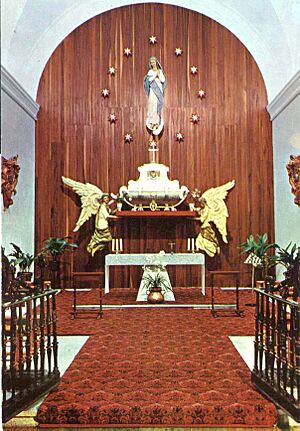

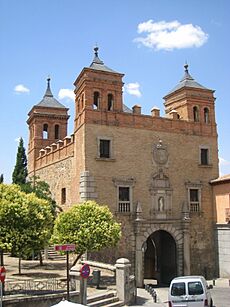
Toledo was named a Historic-Artistic Site in 1940. Later, UNESCO made it a World Heritage Site in 1987. Here are some of the main places to visit:
- The tomb of Saint Beatrice of Silva at the Monastery of the Conceptionist nuns.
- Castle of San Servando: A medieval castle near the Tagus river.
- Cathedral of Saint Mary of Toledo: A stunning Gothic church from the 13th century.
- Monasterio de San Juan de los Reyes: A beautiful monastery built in the 15th century.
- Museo-Hospital de Santa Cruz: A Renaissance museum from the 16th century.
- El Greco Museum: A museum designed to look like the famous painter El Greco's home. It has many of his important paintings.
- Santa María la Blanca: The oldest synagogue building in Europe that is still standing.
- Synagogue of El Transito: Located in the Jewish Quarter, it houses the Sephardic Museum.
- Hospital de Tavera Museum Duque de Lerma: A Renaissance hospital from the 16th century.
- Iglesia de Santo Tome: A 14th-century church that holds El Greco's famous painting, The Burial of Count Orgaz.
- El Cristo de la Luz: A small former mosque built in 999, later turned into a Catholic church.
- Galiana Palace: A 13th-century palace built in the Mudéjar style.
- Alcázar: A large fortress from the 16th century, located on the highest part of the city. It now holds the Army Museum.
- Iglesia de San Andrés: A church with a crypt containing 60 mummies.
- Puerta Bab al-Mardum: The oldest city gate of Toledo, from the 10th century.
- Puerta de Bisagra Nueva: The main entrance to Toledo today, rebuilt in the 16th century.
- Puerta del Sol: A 14th-century gate built by the Knights Hospitallers.
- Alcántara bridge: A Roman bridge across the Tagus River.
- Puente de San Martin: A medieval bridge across the Tagus River.
Getting Around Toledo
Toledo has always been an important stop in central Spain. The old roads leading to the city are still used today.
Roads
- The N-400 road connects Toledo with Cuenca. It is being upgraded to the A-40 motorway.
- The old N-401 road (Madrid-Toledo-Ciudad Real) became the A-42 motorway. This road helps reduce traffic.
- The AP-41 is a toll motorway built to make travel between Toledo and Madrid faster.
- The N-403 connects Toledo to Ávila.
Rail
Toledo was one of the first Spanish cities to get a railway. The first line opened on June 12, 1858. The current Toledo Railway Station was opened in 1919.
In 2005, a new high-speed rail line to Madrid opened. This line reduced travel time to Madrid to less than 30 minutes.
Sports in Toledo
Toledo has many sports facilities. The city council now manages old military sports centers. These include an athletics track, an Olympic swimming pool, and an indoor sports hall. There are also outdoor courts and pools in different neighborhoods.
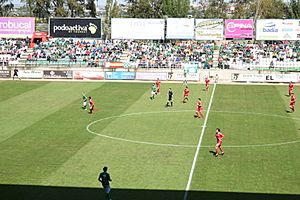
- Football: Toledo has a football team called CD Toledo, founded in 1928. They play at the Estadio Salto del Caballo. The team played for 7 seasons in the Segunda División (second division).
- Basketball: Toledo has two basketball teams: CB CEI Toledo and CB Polígono.
- Athletics: The Toledo Athletic Club is known for its success in cross-country running. Famous athletes like Julio Rey and Chema Martinez have been part of this club.
- Cycling: Cycling is popular in Toledo, especially since Federico Bahamontes, known as 'The Eagle of Toledo', won the 1959 Tour de France.
- Other Sports: Toledo also has a volleyball club and a rugby club.
Media and News
Toledo has several local and provincial newspapers. National newspapers also publish local editions for Toledo. Some local newspapers include La Tribuna de Toledo and El Día de Toledo.
For television, CMM TV, the regional public TV station, is based in Toledo. There are also local TV channels like Canal Diocesano-Popular TV and Teletoledo.
Many radio stations broadcast in Toledo, including Radio Toledo (Onda Cero), COPE, and Cadena SER. There are also online news sources like Onda Toledo and Toledo Digital.
Toledo's Sister Cities
Toledo is connected with other cities around the world as "sister cities." This helps promote cultural exchange and understanding.
- Aachen, Germany (1984)
- Agen, France (1973)
- Corpus Christi, Texas, United States (1989)
- Damascus, Syria (1994)
- Guanajuato City, Mexico (1978)
- Heraklion, Greece (2014)
- Nara, Japan (1972)
- Old Havana, Cuba (2005)
- Safed, Israel (1981)
- Toledo, Ohio, United States (1931)
- Veliko Tarnovo, Bulgaria (1983)
Images for kids
See also
 In Spanish: Toledo para niños
In Spanish: Toledo para niños


